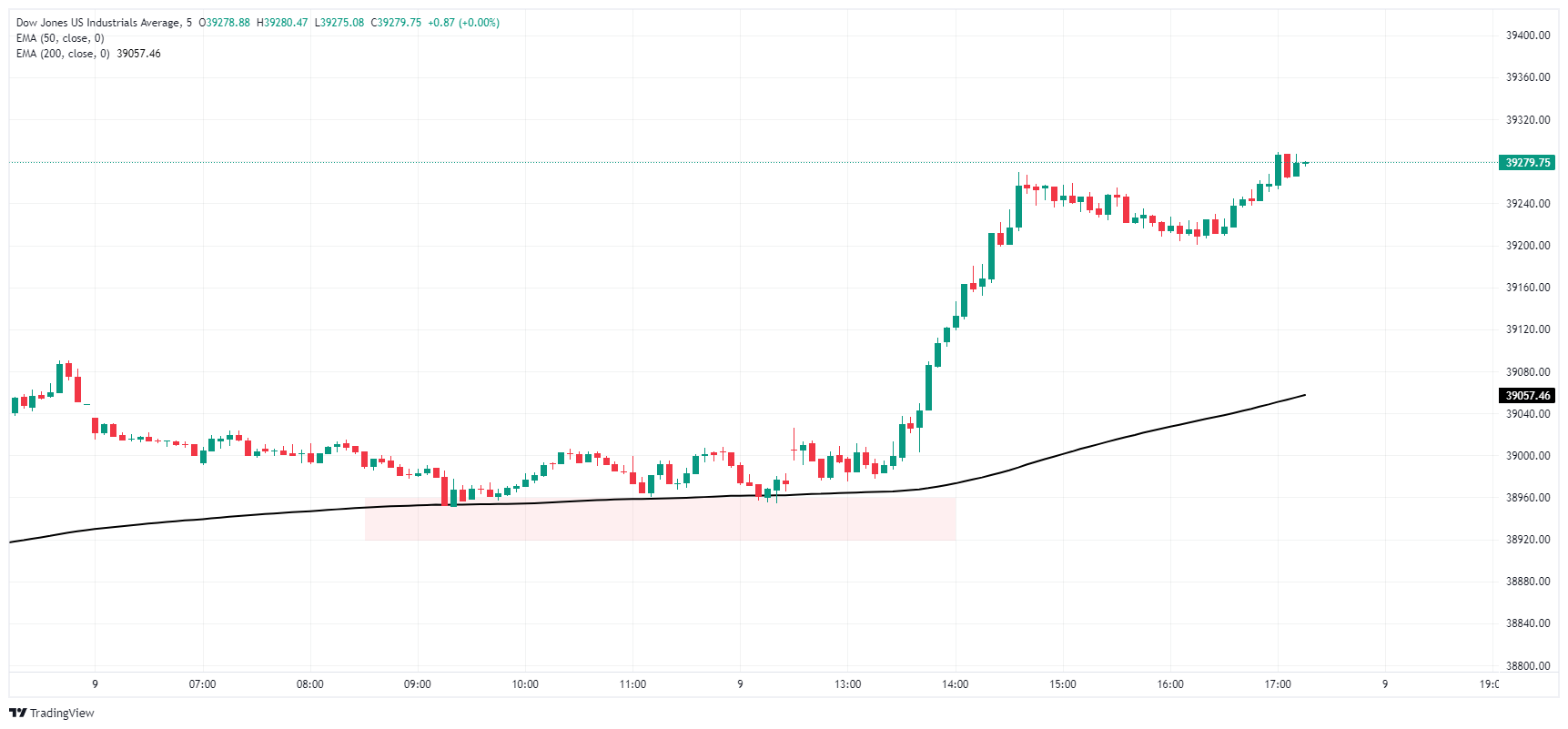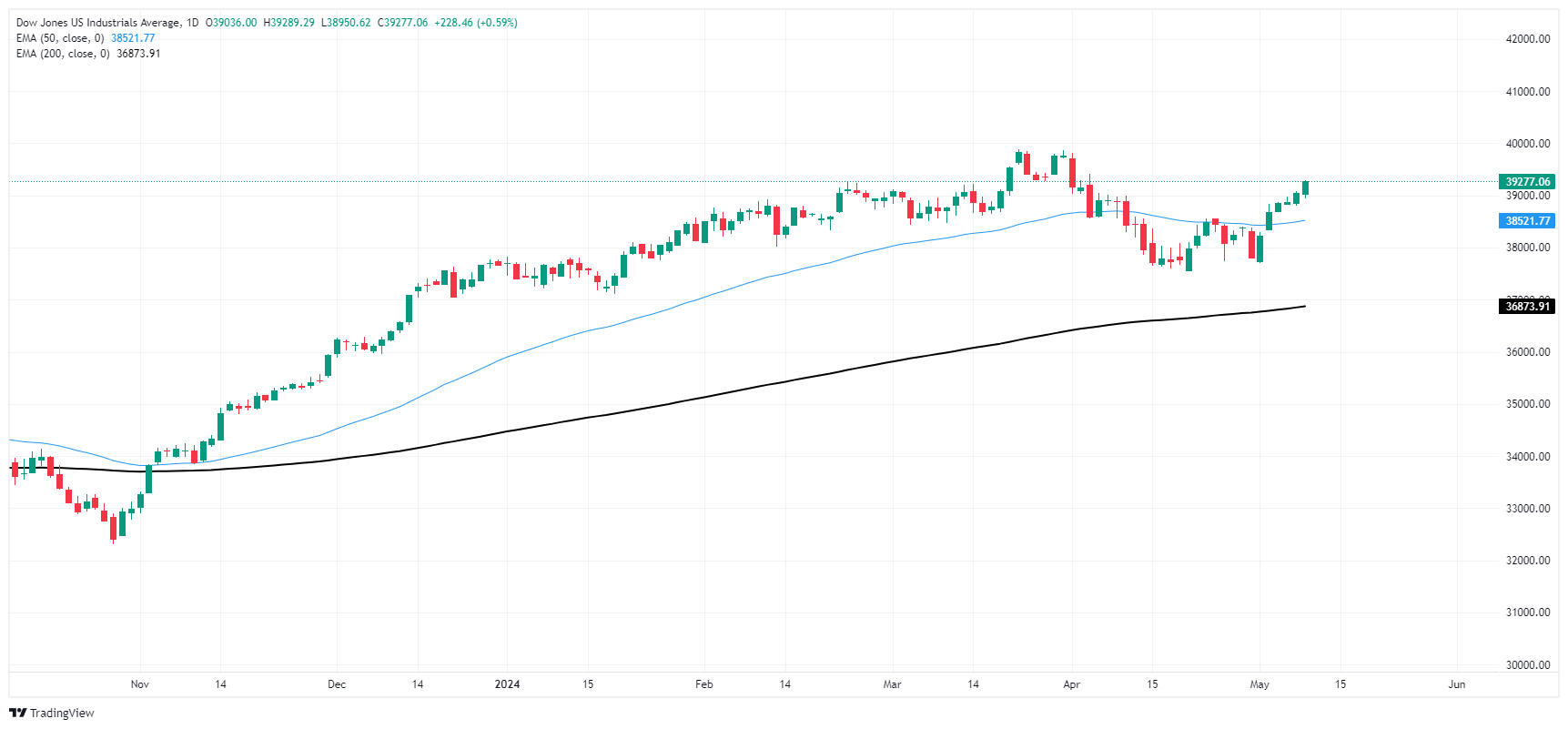Dow Jones climbs on Thursday, Initial Jobless Claims bolster rate cut hopes

- Dow Jones gains ground as equities climb.
- US Jobless Claims hit highest number since last August.
- Markets are pinning hopes on rate cuts from Fed.
The Dow Jones Industrial Average (DJIA) found further gains on Thursday as investors bet on Fed rate cuts to come after US Initial Jobless Claims rose to a multi-month high. Federal Reserve (Fed) officials have been pushing down on rate cut expectations recently as Fedspeak talks down the chances of rate cuts without inflation making further progress to the Fed’s 2% target and signs of slack in the US job market.
US Initial Jobless Claims rose to 231K for the week ended May 3, hitting the highest week-on-week number of new jobless benefits seekers since last August. The previous week’s Initial Jobless Claims were also revised slightly higher to 209K from the initial print of 208K. Rising unemployment claims is helping rate-cut-hungry markets step up hopes that the Fed will get pushed towards the rate cut table sooner rather than later.
Dow Jones news
All but five of the individual securities that comprise the Dow Jones Industrial Average are in the green on Thursday, with Caterpillar Inc. (CAT) leading the charge higher. Caterpillar is up over 2% on the day, trading into $351.46 per share. Analysts have raised forecasts for the company’s stock, with expectations ranging from $380.00 to $435.00 per share as the company diversifies further into energy and mining markets.
On the low side, Salesforce Inc. (CRM) is down -1.6%, falling below $275.00 per share as traders reconsider their earlier bets on the cloud computing company. IBM follows hot on Salesforce’s heels, backsliding -1.0% on Thursday, falling to $166.40 per share.
Dow Jones technical outlook
The Dow Jones is up over 225 points on Thursday, climbing six-tenths of a percent as the major equity index grinds its way back to record highs approaching 40,000.00. The index found an early price floor near 38,950.00, and the DJIA is trading above 39,250.00.
The Dow Jones is on pace to close a sixth consecutive trading day in the green, climbing over 4% from the immediate bottom near 37,708.00. The index’s last swing low is priced in near 37,600.00, and the DJIA is up nearly 6.5% from the 200-day Exponential Moving Average (EMA) at 36,897.69.
Dow Jones five minute chart
Dow Jones daily chart
Dow Jones FAQs
The Dow Jones Industrial Average, one of the oldest stock market indices in the world, is compiled of the 30 most traded stocks in the US. The index is price-weighted rather than weighted by capitalization. It is calculated by summing the prices of the constituent stocks and dividing them by a factor, currently 0.152. The index was founded by Charles Dow, who also founded the Wall Street Journal. In later years it has been criticized for not being broadly representative enough because it only tracks 30 conglomerates, unlike broader indices such as the S&P 500.
Many different factors drive the Dow Jones Industrial Average (DJIA). The aggregate performance of the component companies revealed in quarterly company earnings reports is the main one. US and global macroeconomic data also contributes as it impacts on investor sentiment. The level of interest rates, set by the Federal Reserve (Fed), also influences the DJIA as it affects the cost of credit, on which many corporations are heavily reliant. Therefore, inflation can be a major driver as well as other metrics which impact the Fed decisions.
Dow Theory is a method for identifying the primary trend of the stock market developed by Charles Dow. A key step is to compare the direction of the Dow Jones Industrial Average (DJIA) and the Dow Jones Transportation Average (DJTA) and only follow trends where both are moving in the same direction. Volume is a confirmatory criteria. The theory uses elements of peak and trough analysis. Dow’s theory posits three trend phases: accumulation, when smart money starts buying or selling; public participation, when the wider public joins in; and distribution, when the smart money exits.
There are a number of ways to trade the DJIA. One is to use ETFs which allow investors to trade the DJIA as a single security, rather than having to buy shares in all 30 constituent companies. A leading example is the SPDR Dow Jones Industrial Average ETF (DIA). DJIA futures contracts enable traders to speculate on the future value of the index and Options provide the right, but not the obligation, to buy or sell the index at a predetermined price in the future. Mutual funds enable investors to buy a share of a diversified portfolio of DJIA stocks thus providing exposure to the overall index.
